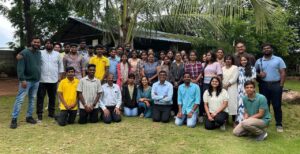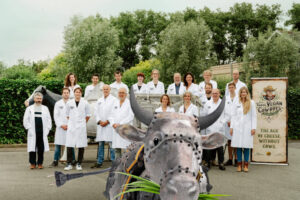Last week, the Australian Farm Institute, an agricultural policy research organization, hosted the Digital Disruption in Agriculture conference. The conference explored whether digital technologies will enable the third agricultural revolution and bring about the next big productivity gain, and how to catalyze this revolution in Australia. In eight sessions across two days, leading academics, established corporations, agtech entrepreneurs, and innovative farmers discussed the challenges and opportunities for digital technologies in Australian agriculture.
Here are my top 5 takeaways:
1. Harnessing the power of data creates limitless opportunities
Digital technologies can provide value to farmers at two levels. Through on-farm connectivity, farmers can monitor the status of equipment, livestock, and water levels. Then, as the farm is connected to the outside world, farmers can access advisors, markets, climate information, and best practices. It was really exciting to see what the future of Australian agriculture can look like.
Multiple speakers went beyond buzzwords like Big Data, IoT, and Machine Learning to explain specific use cases where technology can deliver value to farmers. In particular, University of Sydney professor Salah Sukkarieh showed some pretty compelling videos of robots transforming farming operations. One robot was taught to recognize apples during the growing process, and then measure current yield against predicted future yield. This robot will allow farmers to proactively take management steps in potentially low yielding areas. Another solar-powered robot detects weeds in row crops and automatically sprays herbicide or uproots them using a mechanical arm.
Other speakers highlighted current and potential applications, such as:
• on-farm 3D printing for cheap, quick access to maintenance equipment
• ability to stream “how to” videos or video conference with a trusted advisor
• virtual paddocking capabilities to move livestock automatically from a distance
• real-time decision support, like taking a photo of a struggling plant, uploading it with some diagnostic information, and quickly receiving an analysis that suggests potential causes and optimal next steps
• unlocking funding sources by leveraging on-farm data to provide transparency about working capital resources.
2. But beware of marketing hype!
Despite the huge potential, thus far the digital revolution has over promised and under delivered for Australia’s farmers. Huge technological challenges remain unsolved, such as interoperability –enabling hardware devices and software platforms across providers to work with one another — infrastructure, and connectivity. Farmers have begun to take things into their own hands.
One farmer, Murray Scholz, explained how he used a shipping container and solar panels to build his own fixed wireless solution. As a result, Murray realized huge improvements in upload and download speeds, enabling him to access cloud-based productivity tools — like Dropbox — that many city dwellers take for granted. The world of real-time, on-farm decision support seems like a science fiction movie when even Telstra, Australia’s largest telecommunications company, and nbn, Australia’s broadband network provider, touted benefits such as not dropping calls.
Digital technologies show promise, but we have a long way to go to realize their full potential.
3. Data ownership and privacy concerns abound
This issue was raised many times throughout the conference, and discussed explicitly by Peter Leonard, Sydney’s leading IT lawyer, in a session dedicated to governance. There is widespread agreement that farmers should own their own data. However, it’s not yet clear how to best manage who has control of the data, what can be done with them, and how to distribute the value.
David Clifford, lead quantitative researcher at Monsanto’s Climate Corporation, explained that they protect the farmer’s data, but ultimately the farmer owns them. But the issue may be subtler, requiring language that is more specific and transparent. When you take a photo of someone with your phone, they’re in the photo but you own it, and can do whatever you want with it. Is this analogous to a tractor that collects data on a farm and sends it to a cloud owned by the corporation that sells the tractor? If so, where is the limit on what the company can do with the data, and how should the farmer be compensated, if at all?
Trust in technology remains a huge issue and barrier to adoption. This is increasingly important in a world where more data is produced and used in new and unforeseen ways.
4. The revolution will take more than technological innovation
Organizational and societal changes are also necessary. For example, an innovation ecosystem that incentivizes Australian agtech entrepreneurs is necessary. Australia lacks both commercialization pathways out of universities, as well as opportunities for early-stage businesses to attract capital.
Business model innovation is also necessary; even the best technologies need paying customers to become sustainable businesses. Solutions developed for the Australian context will be critical, as successful businesses in other countries cannot easily apply their technologies to Australian agriculture — corn is not a major crop in Australia, for example.
Increasing adoption of digital technologies will also require innovative approaches. Farmers are not clear on the value proposition of many of these technologies, and don’t feel that they are addressing real problems. Including, but evolving, the role of the trusted advisor — such as an agronomist — may be one solution. Farmers are more likely to trust innovations that augment expertise, rather than replace it. Including farmers in an iterative development process can also help increase adoption. For example, CBH Group, a grain grower’s cooperative, worked with farmers on grain blending algorithms to incorporate feedback, demonstrate incremental improvements, and gain trust. After three years, the software had demonstrated significant value and adoption was no longer an issue.
5. The education system has to evolve
We need to prepare the next generation of farmers, agronomists, and agtech entrepreneurs for an agriculture system in which digital technologies are ubiquitous. To be successful, students will need experience working on interdisciplinary teams that mirror the necessary collaborations between agronomists, producers, technology developers, and entrepreneurs.
Students also need training in foundational skills. Data analysis and software engineering, specifically, as well as a basis in STEM more generally, will be necessary. The agriculture industry will continue to remain critically important for Australia’s economy as it experiences its third revolution. The education system needs to prepare future generations to work effectively with technology, nature, and each other.
What do you think about how the agtech scene in Australia is developing? Get in touch on [email protected]




